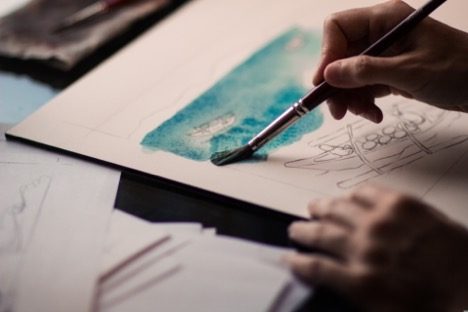Do you want to try your hand at painting but are unsure how and where to start? You might be confused about which medium you begin with, which brush set you should use, and what items you must have to make your journey easier. Well, we have got you covered. This article has gathered the best tips to help you get started and eventually paint like a pro!
1. Choose The Right Medium
One of the first steps is selecting an appropriate media. For their first paintings, most amateur artists choose between three different media:
Acrylics
If you are amazed by the acrylic pour painting tutorial online, this could be the first medium you want to get your hands on. Acrylic paints can be used on various surfaces, including conventional paper and canvas sheets, and dry quickly. Also, if the color is too thick, you may simply dilute it with water because it is water-soluble. Be careful with diluting acrylics too much though if they get too watered down they won’t bind to the surface you’re painting on and they will flake off. Don’t dilute it more than 30%. Additionally, acrylic paints are more afforadable, flexible, and simple to clean up after use.
Oils
As a result of its extended drying period, oil paints is a preferred medium for artists who want to take their time working with a wet painting over a period of weeks. This will give you more freedom in combining colors and experimenting with different brushstrokes. Oil painting is sometimes seen as too difficult for beginners to attempt, taking oil lessons, watching youtube videos and understanding oil mediums will help you master this medium quickly. Read this blog post to learn what you can and can’t mix with oils.
Watercolors
Watercolors are a simple and easy to approach medium. Just like acrylics they are water soluble. What’s more, if you can master the quick-drying consistency of watercolors and play with dilution and layering of colors the possibilities are endless.
2. Use Good Quality Art Supplies
When starting out it’s okay if you experiment with inexpensive materials. However as you gain skill, techniques and play with higher quality paints you will quickly be able to see the difference between low quality paints and high quality paints. If you’re interested in professional painting you should always use high-quality materials. If you’re noticing that cheap paints tend to produce murkier or duller effects look for paints that are of a higher quality and contain more pigment per tube. Your paintings will have a newfound clarity and radiance, and will usually bind better to your surface.
What you need to get started painting is as follows, according to the norm for beginners:
Blend of Colors: You can start by getting primary colors. In that way, you will also learn color mixing to create different shades. Use a color wheel to get a good sense of the rules of color and how to mix colors to get your desired palette.
Brushes: Choose brushes depending on your choice of medium. Different brushes give you a variety of effects. Try a lot of brushes. You will quickly learn that some techniques are much easier to achieve with a different type of brush. Natural brushes from animal hair, furr, synthetic, or even sponges all create different effects. Play with different brushes to achieve different techniques.
Palette: For mixing colors.
Palette Knife: For mixing paint on your palette.
3. Learn the Basics
It’s helpful to learn some of the basic principles of painting. Don’t expect your early work to be your favorite. Nothing will be a masterpiece when you begin. Study and preparation is required to learn techniques and better understand the tools of painting. Learn the basics of painting by focusing on these areas:
The Importance of Color Mixing
Learn basic color theory. Memorize your primary, secondary and tertiary colors. Once you can confidently mix any color from primary colors. The more you practice the easier and faster it is to mix colors from primaries.
Learn to Paint with a Variety of Techniques
You’ll discover that the medium you’re working in will affect how your brushstrokes look. The brush sizes and types you use will also affect the brushwork you produce. Play with different brushes, palette knives or other non traditional materials.
Conclusion
Learning to paint is not something that happens overnight. Starting with realism, understanding your medium and taking time to find what you like is important. There is just one hard and fast rule when it comes to painting, and that is that you should enjoy yourself as much as possible. The more fun you have when painting, the better the final product will be.


